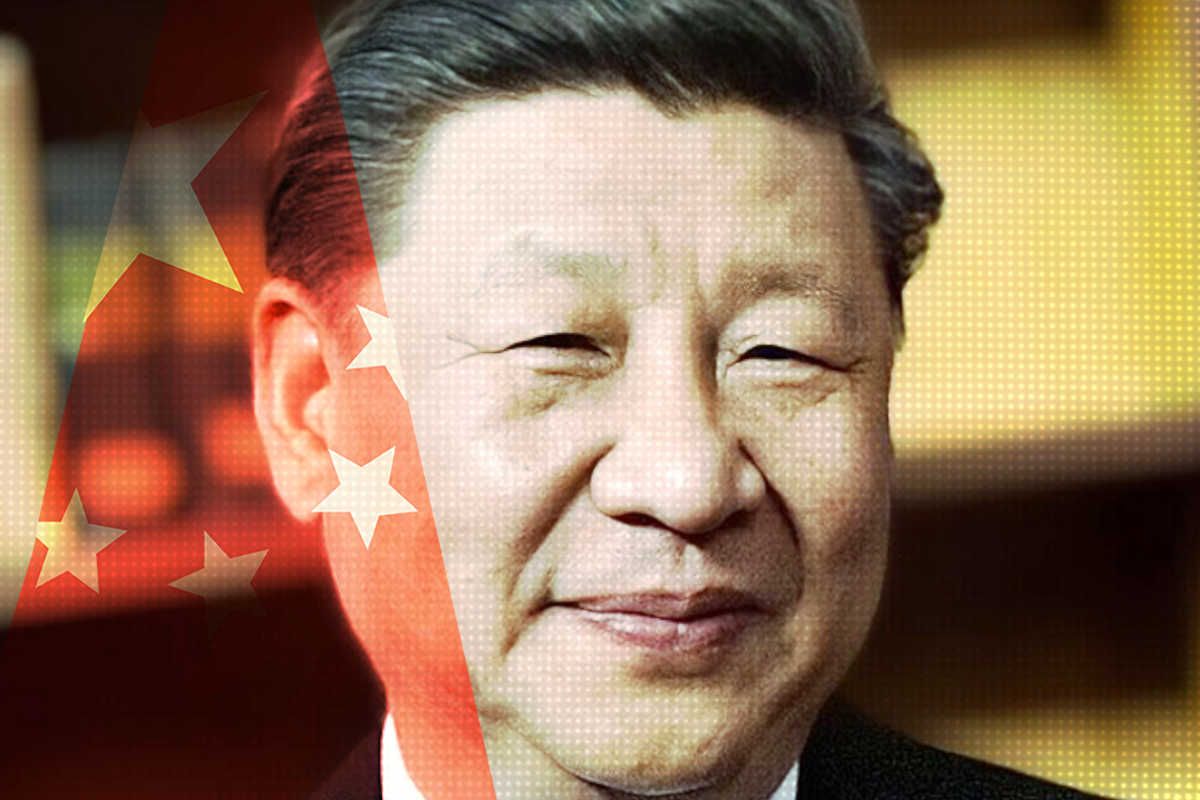China Newspeak
China Discourse Report 2018
For 2018, we could say that the most important testing point (测试点) in China’s political discourse arena was the contraction of President Xi Jinping’s political “banner term,” or qizhiyu (旗帜语), “Xi Jinping Thought of Socialism With Chinese Characteristics for a New Era” (习近平中国特色社会主义思想), which was formally introduced at the 19th National Congress of the Chinese Communist Party in November 2017.
What do I mean by contraction?
This long and unwieldy political phrase is meant to be Xi Jinping’s political brand, forming and consolidating his legacy, and it is set apart from the banner terms of Xi’s predecessors, Hu Jintao and Jiang Zemin, by including his name, an important mark of Xi Jinping’s power. But to become a phrase on par with previous legacy phrases like Mao Zedong Thought (毛泽东思想) or Deng Xiaoping Theory (邓小平理论), both of which “crown” (冠名) top Party leaders, this latest banner term would need to undergo a process of contraction. And of course the contraction we should expect is “Xi Jinping Thought,” which was strategically imbedded in the expanded “Xi Jinping Thought of Socialism With Chinese Characteristics for a New Era.”
We have to assume, given the nature and role of political discourse within the Party’s political culture, that this was the intention all along — that “Xi Jinping Thought of Socialism With Chinese Characteristics for a New Era” was introduced with a mind to reducing it down as soon as the conditions were right.
The pace of this contraction process is a reflection of the degree of power wielded by Xi Jinping and the core of top Party leaders at his side. At CMP, we predicted previously, as Xi Jinping’s banner term became clear, that the contracted “Xi Jinping Thought” would emerge within the year following the 19th National Congress. In fact, we could see the process unfolding in the Party-state media, with the emergence of a number of transitional phrases (过渡性提法), but this process was ultimately slower than we anticipated, impacted by the broader domestic and international environment.
We’ll come back to this question of banner terms at the end of this report.
When the National Language Resources Monitoring and Research Centre for Print Media (国家语言资源监测与研究中心) at Beijing Language and Culture University released its list of “Top Ten Terms in the Chinese Media” for 2018 on December 24, these included “constitutional amendment” (宪法修正案) and “trade tensions” (贸易摩擦), phrases we should understand as reflective of these environmental factors to which I just alluded.
From Hot to Scalding
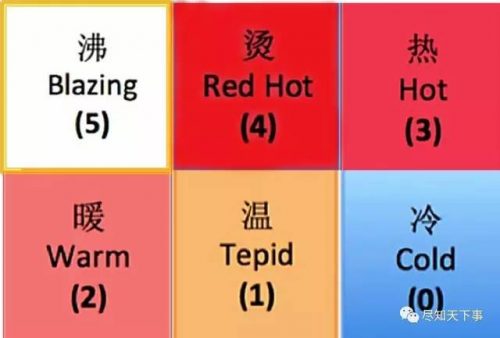
According to the “heat index” CMP has developed for the intensity of certain phrases in the Chinese political discourse as reflected in the People’s Daily, the flagship newspaper of the CCP, in 2017 the phrases that were hottest, in the “blazing” category, were the “Belt and Road [Initiative]” (一带一路), “19th Congress” (十九大), “Socialism With Chinese Characteristics” (中国特色社会主义) and “with Comrade Xi Jinping as the core” (以习近平同志为核心). This means that each of these phrases appeared in 2,000 or more articles in the People’s Daily for the year.
For 2018, we have four phrases making it into the “blazing” category: “Belt and Road,” “Xi Jinping Thought of Socialism With Chinese Characteristics for a New Era,” “19th Congress” and “Reform and Opening” (改革开放).
Since 2013, “Reform and Opening” has consistently been a “red hot” phrase in the People’s Daily, but has not until now entered “blazing” territory, and in fact we have seen the steady decline of the phrase from year to year. This year, owing to the 40th anniversary of “Reform and Opening,” the phrase rapidly heated up. You can see the heat intensity of “Reform and Opening” plotted below for each year from 2013.
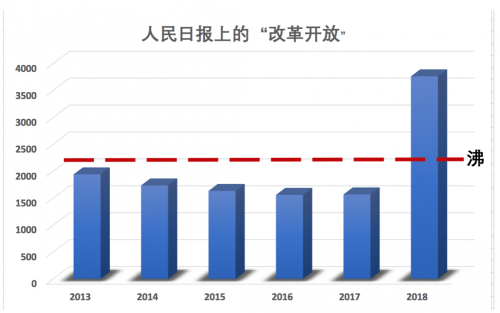
In 2018, we also saw a slight increase in the use of Deng Xiaoping’s name in the People’s Daily, but the previous state in which we could say, “Mao is red hot, Deng is just hot” (毛烫邓热,毛高于邓) — meaning that Mao is consistently elevated above Deng — was unchanged.
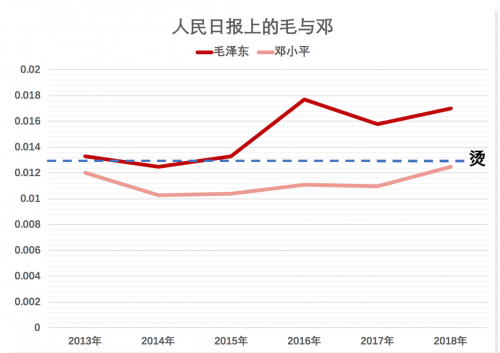
Another word we saw rising quite dramatically this year was “red” (红色), which of course is typically an indicator of tribute to the history and legacy of the Party. In 2018, the word remained in the “red hot” sector, but was up substantially, its frequency of use this year being in fact a 169 percent increase on the frequency five years ago.
The political slogans (政治口号) of China’s leadership are generally reflected in those political phrase making it into the top three sectors of the heat index, “blazing,” “red hot” and “hot.” Here, then, are those political slogans so defined:
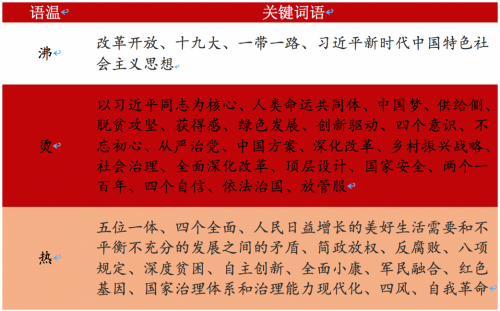
In the second category, “red hot,” we see a number of phrases that should be quite familiar to anyone with an eye trained on Chinese political discourse, phrases like “with Comrade Xi Jinping as the core,” “community of common destiny for humanity,” “Chinese Dream,” “supply side,” “attack on poverty,” the “Four Consciousnesses,” the “Four Confidences,” “national security” and so on.
We defined for this study 13 “old” Party terminologies, terms like “Deng Xiaoping Theory,” to monitor whether or not there was any change, and found that these held steady, with no notable alteration in intensity. Meanwhile, terms we generally look to as indications of more progressive agendas in the direction of political reform, in particular “political system reforms” (政治体制改革) and ”intra-party democracy” (党内民主), continued in their track as “cold” terms (冷词), defined in our index as those terms having 0 occurrences in the People’s Daily.
“A Perilous Situation”
The image you see below is a portion of the front page of the People’s Daily from August 11, 2018. It is a highly unusual page to find in the newspaper, and it is the first time that the term “stable expectations,” or yinyuqi (稳预期) has appeared in a headline in the Party’s flagship newspaper. In this case, “expectations” is essentially about confidence (信心) — specifically, confidence in China’s economy and its general health.
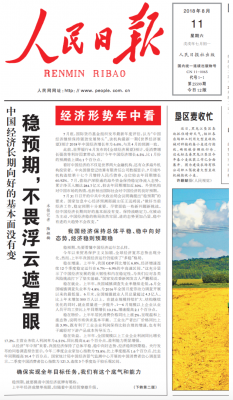
We can see that the smaller headline boxed in in red reads: “Looking At the Economic Situation at Mid-Year.” And down below this, the first bold subhead reads: “Our Country’s Economy Maintains Overall Stability.” So the claim on the surface is that things are generally going well for China’s economy. There is no cause for concern.
But reading Chinese political discourse is of course all about reading between the lines. Party leaders in China have made a virtual art form of writing, signalling and reading between the lines. So what does this actually indicate to us?
In the history of the People’s Daily to date, “stable expectations” has appeared in a headline just twice, both times in August 2018. If we then look at occurrence of this term in a full text search, we find that it appears just three times in the first half of 2018 in the newspaper, but appears 48 times in the second half of the year.
This seems to suggest that “stable expectations” has been a term of some significance since the middle of 2018. If we then turn to the Qianfang (前方) database, which gives us access to a broader range of periodicals in China, here is the trend we can see with respect to this term “stable expectations” in Chinese newspapers.

The ongoing trade war between China and the United States has resulted in a dramatic reconfiguration of the Chinese political discourse as it concerns questions of economy and trade. The first half of 2018 and the second half of 2018 are vastly different in the terms that dominate and characterise them. “Stable expectations” is just one example, a term that seems to signal an effort to put a pleasant face on the situation while not overplaying China’s hand.
Another mark of the change between the first and second halves of the year is the phrase “Amazing, my country” (厉害了,我的国), which now seems to epitomise China’s overplaying of its hand. The phrase follows a state-produced documentary film of the same name — referred to in English as “Amazing China” — that in March 2018 became the highest-grossing documentary film of all time in China. The documentary was a boastful paean to the great technological and economic achievements China has made, particularly under the leadership of President Xi Jinping. The documentary was loudly trumpeted by state media through March. But, tellingly, the film was pulled from store shelves in China toward last spring.
In 2018, Chinese internet users riffed on the documentary to create the neologism “amazing country” (厉害国). But here is what the phrase “Amazing, my country” looks like if we divide occurrences of the term in Chinese newspapers between the first and second halves of 2018.
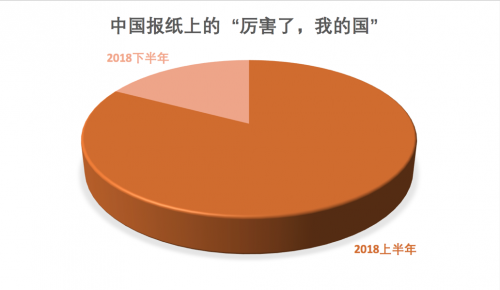
In a sense, we have the mirror image of “stable expectations.” Overbrimming confidence gives way to cautious reassurance. What a difference a few months can make.
During the second quarter of 2018, as the trade war between China and the United States was just starting, the tone of China’s media (媒体语气) was notably hard-line and unyielding. The following is an opinion piece in the Global Times, published by the People’s Daily, that speaks in hard-line terms of the need to stand up and resist the United States. It speaks openly of both sides making preparations for a trade war.

And we have also this headline, from July 2018, in which the Global Times speaks of a “war of self-protection” against the United States, with a visually arresting image of conflict and opposition.

But things change quite remarkably when we move ahead just a few months into the second half of the year. Here is another piece, also from the Global Times, but from October 2018. The headline of this later Global Times piece, “Trade War Wakes China, Our Society is Maturing” (贸易战唤醒中国, 我们的社会在成熟), is far more circumspect, and far less combative.

The article itself speaks of the trade war as a “tremendous test” (巨大考验) of China’s “strategic patience” (战略耐心), as opposed to the anger, impetuousness or despair with which China might respond to such challenges from a trade partner. The message is that China should hold steady to its path, and not allow the shock of the trade war, which it calls “sudden” (突然), send it either along a path of foolhardy resistance to the death, or a newly conservative isolation.
Here is what we find when we look at two other phrases that have spoken to China’s unbridled confidence in its strengths, “Made in China 2025” (中国制造2025), referring to the industrial development strategy that has been the focus of a great of concern from many developed economies, and the “China Solution” (中国方案), the idea that China has a unique model for development that might be emulated by other countries — with implications, some fear, for global norms. The following charts show the proportion of total articles in China’s newspapers using the terms “Made in China 2025” and “China Solution” in the first and second halves of the year.
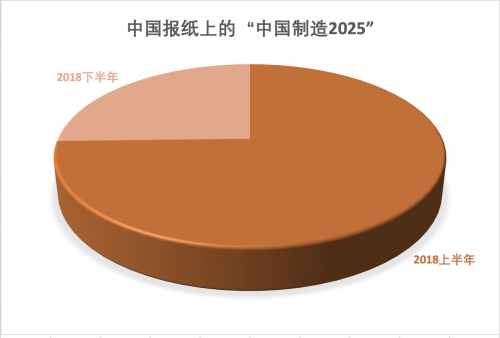
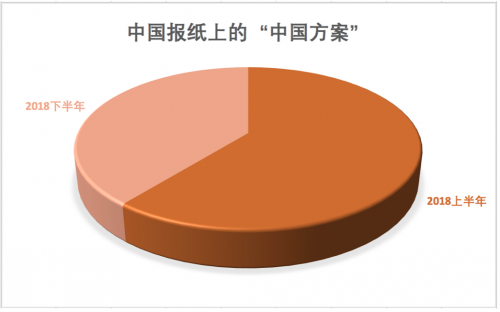
Clearly, both of these terms were far more prevalent in the first six months of 2018 than in the second six months, suggesting that both, as terms in the official discourse, were subject to some level of restriction as the leadership responded to changes in the international environment, and to subject impacts on the domestic political environment.
The signs in the discourse indicate that the pressure has been very real. In his most recent address to commemorate the 40th anniversary of China’s reform and opening policies, President Xi Jinping spoke of “a perilous situation that beggars the imagination” (难以想象的惊涛骇浪), a clear warning that China faces immense challenges ahead.
If we look at the phrase “financial risks” (金融风险) in the People’s Daily, we again see a noticeable rise in the prevalence of the phrase. In 2015 and 2016, “financial risks” was in the “warm” sector, but by 2016 it had become “hot,” according to our index. And the term has continued to rise, as you can see here:
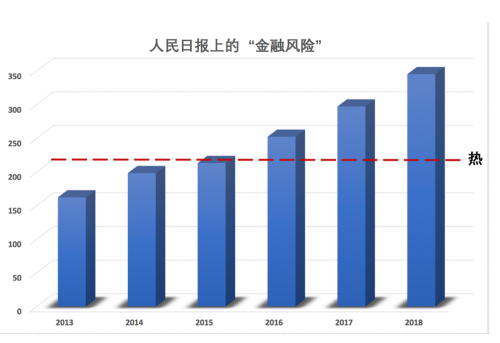
There is also very clear talk of downward pressure on China’s economy such as has not been experienced in four decades. The following graph shows articles using the term “downward pressure” in each quarter of 2018, based on a search of the full Qianfang database of more than 400 mainland newspapers. We can see use of the term more than doubling from quarters three to four.
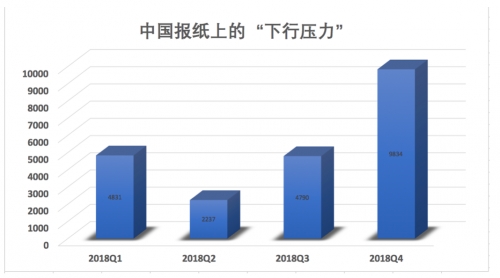
Praising the Leader
In our discourse report for 2017, we noted an instance late in the year of the “rapid deceleration” (刹车) or “temporary stop” (‘临时停车) in certain key terminologies in the wake of the 19th National Congress of the CCP. On November 1, 2017, the Central Committee released a document called “Decision Concerning the Study and Implementation of the Spirit of the 19th Congress” (关于认真学习宣传贯彻党的十九大精神的决定), which spoke of “focusing on General Secretary Xi Jinping as the Party leader [1] cherished by the whole Party, [2] loved and respected by the people, and [3] worthy of the title” (聚焦到习近平总书记是全党拥护、人民爱戴、当之无愧的党的领袖上).
I’ve added the numbers in the translation above to show what have been called the “Three Standards” (三语标配), which were very widely propagated by China’s Party-state media during the first half of November 2017, but which noticeably dropped in the second half of the month. Why did we see this rapid deceleration? It seems to me that the push to emphasise Xi Jinping’s preeminent status as the head of the Party backfired somewhat as local and regional leaders fell over themselves to pay tribute to Xi. As we documented in last year’s annual report, there was at least one case of a local Party newspaper honouring Xi Jinping as the “Great Leader,” or weida lingxiu (伟大领袖), an honorific used in the past for Mao Zedong alone.
This tide of praise seems to have prompted a backlash, and so the “Three Standards” were quickly reeled in. However, other honourifics quickly emerged in their place, as though the leadership was testing the political waters. We had: “Leader of the Party, Commander of the Army, Leader of the People” (党的领袖,军队统帅,人民领袖); and “Respect the Core, Gives Allegiance to the Core, Protect the Core” (忠诚核心,拥戴核心,维护核心,捍卫核心). Both of these phrase rose rapidly during the first quarter of 2018, but diminished sharply in the second quarter. And by the third quarter, heading into the second half of 2018, all of these phrases had fallen low. The following graphs show total articles using the phrases in Chinese newspapers, on the basis of the Qianfang database:
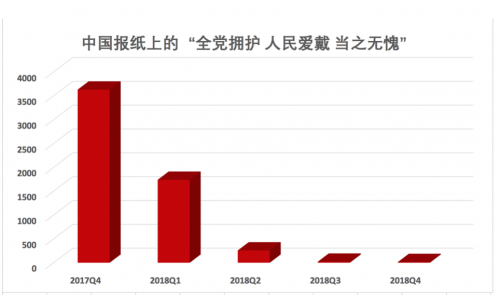
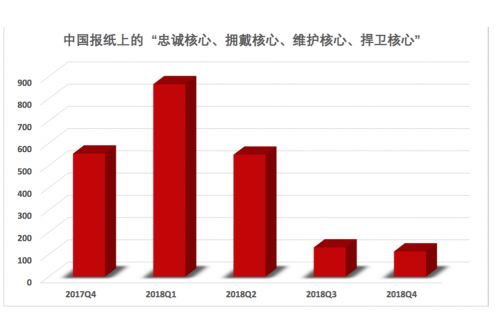

Aside from these three phrases, there was another this year, a rather strange one, that emerged only in June with the publication by the CCP’s Central Office of the July edition of the official magazine so enticingly called Office Administration (秘书工作). Chinese discussants on the WeChat social media platform noticed something interesting about the edition, namely that Ding Xuexiang (丁薛祥), the head of the office and general regarded as Xi Jinping’s most important political aide, had used a new set of three buzzwords to refer to Xi.

Those three buzzwords were:
“goes willingly into a sea of bitterness” (甘入苦海)
“attends to public affairs day and night” (夙夜在公)
”dedicates himself to the cause of the Party” (以身许党).
The three buzzwords were a great deal more humble, focusing on Xi Jinping’s sense of dedication and service, his tireless dedication. They are of course important and noteworthy because we have them from Ding Xuexiang, at the highest levels of the Party. They were used quite a bit at the time on social media, including official accounts. But somewhat puzzlingly, they did not appear at all in the People’s Daily or in other official Party publications. There is only the single mention in Office Administration.
When we talk about this sort of propaganda around the person of Xi Jinping and his position and importance to the Party, we cannot overlook the term “Great Teaching of Liangjiahe” (梁家河大学问), which CMP took a look at back in June 2018. Liangjiahe refers to the village in China’s northwestern province of Shaanxi where Xi Jinping spent seven supposedly formative years as a sent-down youth during the Cultural Revolution. Tales of Xi’s time in the village have become an integral part of the myth building up around the president. In our June piece, we looked in particular at a notice posted by the Shaanxi Academy of Social Sciences to its official website calling for submissions for new research projects dealing with the “Great Teaching of Liangjiahe,” one of a number of signs of a rising attitude of worship around Xi.
The phrase “Great Teaching of Liangjiahe” actually has its origins in something Xi was reported to have said in 2015 when he made a return trip to Shaanxi: “Do not underestimate Liangjiahe, for this is a place of great teaching” (不要小看梁家河,这是有大学问的地方). As the 19th National Congress approached in the fall of 2017, the phrase “Great Teaching of Liangjiahe” was propagated quite enthusiastically in the Party-state media surrounding the publication of the book Xi Jinping’s Seven Years as a Sent-Down Youth (习近平的七年知青岁月). And during the first half of 2018, the phrase was solidly in “hot” territory, according to our index.
But in the second half of 2018, propaganda surrounding the phrase “Great Teaching of Liangjiahe” was also reined in. Here is how the word “Liangjiahe” appeared through the four quarters of 2018 in the People’s Daily, which among state media was relatively conservative in its use of the word, and of the full phrase “Great Teaching of Liangjiahe.” The graph plots the total number of articles using the word “Liangjiahe.”
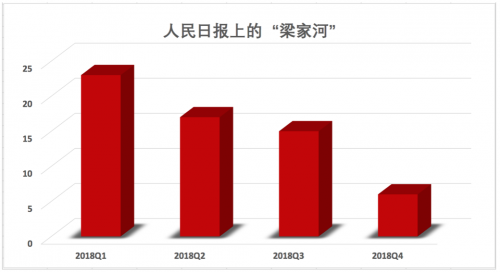
All of the above-mentioned phrases concerning the status of Xi Jinping, which in various ways reflect the level of respect and power accorded to him, share a common pattern — namely, that they were robustly put into play in the first half of 2018, and then moderated or dropped in the second half. So the pattern is clearly the adjustment and holding back of discourse signalling Xi’s power and authority. But of course, it is impossible for us to know exactly what the situation is internally.
“One Position as the Highest Authority”
One of the most particular phrases to emerge within the political discourse in 2018 was the Chinese idiom “one position as the highest authority,” or dingyu yizun (定于一尊), which we wrote about at CMP back in late July. This phrase has long been used with quite negative connotations in Chinese, linked for example to the rule of Emperor Qin Shi Huang (秦始皇), who unified China with the end of the Warring States period in 221 BC, and to the notion generally of power that escapes constraint. In his political report to the 19th National Congress in November 2017, Xi Jinping himself used it in a negative sense, saying that political systems “cannot [establish] one position as the ultimate authority” (不能定于一尊).
Strangely, however, this phrase had been used since 2017 with exactly the opposite meaning as well. On March 14, 2017, the Three Gorges Metropolis Daily (三峡都市报), a commercial newspaper published by the official Chongqing Daily (under the municipal Party leadership), reported that leaders in Chongqing’s Wanzhou District had stressed the need to “protect with real actions the authority of the Party’s Central Committee to set the tone for all and be the ultimate authority” (以实际行动维护党中央一锤定音、定于一尊的权威). Then, on June 16, 2017, the People’s Daily reported that “central governmental organs and departments protected unflinchingly with real actions the power of the Party’s Central Committee with Xi Jinping as the core to set the tone for all and be the ultimate authority” (中央国家机关各部门以实际行动坚定不移地维护以习近平同志为核心的党中央一锤定音、定于一尊的权威).
These departures in the original sense of the phrase dingyu yizun did not draw notice until the same departure was delivered from the mouth of the highest authority himself. Finally, on July 5, 2018, the People’s Daily reported that Xi Jinping had said at the National Organisational Work Conference (全国组织工作会议): “The Party’s Central Committee must set the tone for all and be the ultimate authority” (党中央必须有定于一尊, 一锤定音的权威). From that point, of course, Party-state media all followed suit.
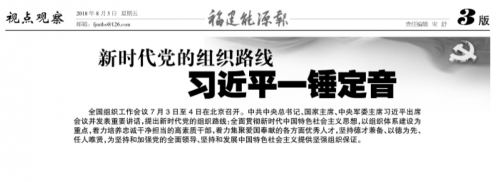
But the use of “set the tone for all and be the ultimate authority” actually varies between various local and regional Party media. When we look at media from region to region, we find that Jiangxi, Shaanxi and Xinjiang use the term with the greatest frequency, and Tianjin, Beijing, Shanghai and Hainan use the term the lowest frequency. Use of the term in Jiangxi, for example, is 15 times that of Beijing, as you can see from the following map:
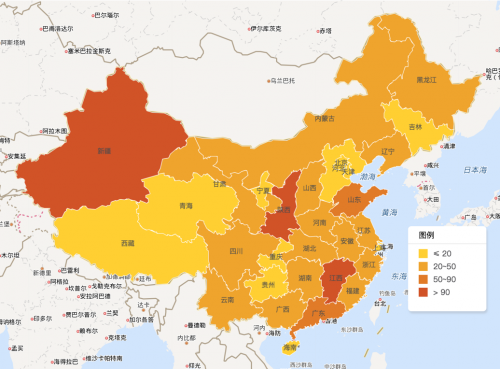
But if we search the People’s Daily and provincial-level Party newspapers on a monthly basis across the year, we find that use of the phrase “set the tone for all and be the ultimate authority” is steadily declining across the board through 2018. In December, the phrase is used in just four articles in both Xinjiang and Heilongjiang.
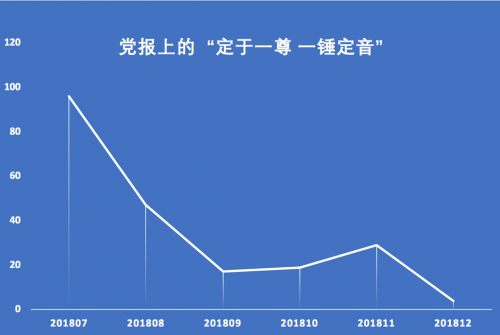
In mid July, the following front page of the People’s Daily, from July 9, 2018, was shared across social media, with some wondering why Xi Jinping was missing altogether.

Some media outside China followed up on the discussion, suggesting that the July 9 edition was unusual — and some even reporting that this was the first time in five years that Xi had not been on the front page of the People’s Daily. In fact, a quick search reveals that this in fact is untrue.
In the almost six years from the time Xi Jinping came to power in November 2012 to December 28, 2018, there have been a total of 482 front pages of the People’s Daily without headlines or subheads including “Xi Jinping,” “General Secretary” or “Chairman Xi.” There were 111 such pages in 2013, 74 in 2014, 97 in 2015, 88 in 2016, and 20 in 2018.
What we should notice is that in 2018 front pages of this kind were far fewer than in previous years. In other words, 2018 has been a year during which Xi JInping is in the headlines on the front page of the People’s Daily with much greater frequency than in previous years.
During the first half of the year, we have March and May during which Xi was in front page headlines every single day. Then we have July and August, each of which had four days without Xi Jinping in the front page headlines (including the day that led to the misleading speculation).
During the second half of the year, September and November were also months during which Xi was in the front page headlines every day. Page layout choices are of course also a form of discourse, and page layout choices at Party newspapers are closely connected to those in power.
“442”
The formula “442” is a fixed combination of various Xi Jinping catchphrases that we should observe. This formula first appeared in September 2018, a shortened reference to “strengthening the ‘Four Consciousnesses,’ adhering to the ‘Four Confidences,’ achieving the ‘Two Protections.'”
These three political phrases are themselves combinations of other phrases, as follows:
“Four Consciousnesses” = consciousness of the 1) need to maintain political integrity, 2) think in big-picture terms, 3) uphold the leadership core, and 4) keep in alignment”Four Confidences” = 1) confidence in the path, 2) confidence in the theories [of the Party], 3) confidence in the system [of socialism with Chinese characteristics, 4) confidence in [China’s unique] civilisation
“Two Protections” = 1) protecting the core status of General Secretary Xi Jinping, protecting the central, unified leadership of the Central Committee of the CCP
The “Four Confidences” emerged in its earliest form in 2013, as Liu Yunshan (刘云山) raised the “Three Confidences” (path, theories and system). In 2014, after the Second Session of the 12th National People’s Congress, Xi Jinping added culture to the mix, forming the “Four Consciousnesses,” though the shortened phrase did not formally appear until July of 2016 in the People’s Daily.
The “Four Consciousnesses” are clearly associated with the “core” status of Xi Jinping, but the un-shortened form of the phrase had already been raised at a meeting of the Politburo in January 2016, nine months before Xi Jinping was formally conferred “core” status at 6th Plenum. Three weeks after the Plenum, Party media began using the shortened form of the phrase.
The notion of “protecting Xi” (维护习) emerged in the military. In March 2014, Zhang Youxia (张又侠), a member of the Central Military Commission introduced the language, “resolutely protecting the authority of General Secretary Xi” (坚决维护习主席的权威), which appeared in the Liberation Army Daily on March 21, 2014. In February 2015 the Work Committee for Departments Directly Under the CCP Central Committee first introduced the phrase “resolutely protecting the authority of the Party’s Central Committee, resolutely protecting the authority of General Secretary Xi Jinping” (坚决维护党中央的权威, 坚决维护习近平总书记的权威), which appeared on February 9, 2015, in the People’s Daily. Two weeks later, an article clearly originating with the People’s Liberation Army first introduced the phrase, “resolutely protecting the authority of the Party’s Central Committee, resolutely protecting General Secretary Xi Jinping as the core” (坚决维护中央权威, 坚决维护习近平总书记这个核心), which appeared in the February 25, 2015, edition of Legal Daily. Clearly, the “Two Protections” appeared in Chinese newspapers far in advance of Xi Jinping’s formal designation as “the core.”
On November 15, 2016, after Xi Jinping had been designated as “the core,” Politburo Standing Committee member Li Zhanshu (栗战书) published a piece in the People’s Daily called “Resolutely Protecting the Authority of the Central Committee” (坚决维护党中央权威), which included the phrase “protecting the authority of the Party’s Central Committee means first of all protecting the core status of General Secretary Xi Jinping” (维护党中央权威首先要维护习近平总书记的核心地位).
On September 21, 2018, Xi Jinping led a meeting of the Politburo at which the “442” formula packing together all of the above phrases was raised formally for the first time. And on December 27, 2018, “442” made it into a front page headline in the People’s Daily for the first time.

This report concerned a recent Democratic Life Meeting (民主生活会), a periodic meeting of cadres during which they engage in self-criticism, an older CCP practice revived since 2013 under Xi Jinping. It praised Xi Jinping, saying: “Taking the long and broad view in strategic assessments, superbly adept in his political leadership, his position with the people clear and firm, fierce in taking up his historical responsibility, he is fully confirmed as worthy core of the Central Committee, and the core of the whole Party.”
If we look at Party newspapers regionally, we find that Guangdong province has used the “442” formula most readily, followed by Xinjiang, Shandong and Sichuan, while Beijing, Jilin, Ningxia, Tianjin and Shanghai have used the formula much less. The following map is based on a search of newspapers in each region in the Qianfang database for the total number of articles in 2018 mentioning the formula. While the number of newspapers in the database for each region vary, there seems to be no correlation with the number of articles using the term. For example, Beijing, which has more newspapers represented than any other region, made very little use of the term.

In December 2018 (up to the 29th), the People’s Daily had 23 articles using the “442” formula, making it a “hot” term for the month. When we look at the formula’s use in all newspapers across the country during the second half of 2018, we see a clear pattern emerging.
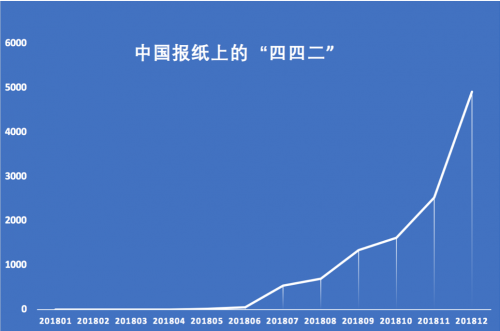
We can see that the political buzzwords and related formulas referring to China’s top leader have been in a state of flux, with many readjustments through the year. And in the midst of these fluctuations, the recent rise of the “442” formula is one of the most obvious signs that the process continues.
Banner Terms
The political report to the 19th National Congress of the CCP was the work of Xi Jinping, and when it came to framing his own banner term for the report, it was not yet political convenient for him to attempt crowning himself, or guanming (冠名), by including his name in his chosen catchphrase. And so it became in the report: “Socialism with Chinese Characteristics for the New Era” (新时代中国特色社会主义思想). The process of crowning nevertheless happened almost simultaneously, as Zhang Dejiang (张德江), Yu Zhengsheng (俞正声) and Liu Yunshan (刘云山), all three retiring members of Politburo Standing Committee, used the phrase “Xi Jinping Thought of Socialism with Chinese Characteristics for the New Era” during a group discussion (分组讨论) on October 18, the first day of the congress, which appeared the next day in the People’s Daily.
This exceedingly long banner term is most definitely not the final version. It awaits contraction. In the history of the Chinese Communist Party, the combination of a person’s name with the word “thought” was a momentous event, and only Mao could achieve it. As soon at the 19th Congress was over, the process of contraction toward “Xi Thought” began.
In fact, as early as 2013 we could find Chinese periodicals using the phrase “Xi Jinping Economic Thought” (习近平经济思想), as the People’s Tribune, a journal launched under the People’s Daily during Jiang Zemin’s administration, did in its 12th edition in 2013. After Xi Jinping’s formal designation as “the core” during the 6th Plenum in the fall of 2016, there were attempts to test the waters through the pages of the People’s Daily. In March 2017, Ji Bingxuan (吉炳轩), a vice-chairman of the Standing Committee of the National People’s Congress, used “Xi Jinping Economic Thought” in remarks included in the newspaper. In June 2017, foreign minister Wang Yi (王毅) used “Xi Jinping Foreign Relations Thought” (习近平外交思想). Three months later, in September, Tie Ning (铁凝), the head of the All-China Writers Association, introduced the phrase “Xi Jinping Thought on Literature and Art” (习近平文艺思想).
In 2018, by our estimates, at least 23 various forms of “Xi Thought” appeared in the Chinese media, including: “Xi Jinping Economic Thought” (习近平经济思想), “Xi Jinping Foreign Relations Thought” (习近平外交思想), “Xi Jinping Thought on Literature and Art” (习近平文艺思想), “Xi Jinping Strong Military Thought” (习近平强军思想), “Xi Jinping Education Thought” (习近平教育思想), “Xi Jinping Ecological Civilisation Thought” (习近平生态文明思想), “Xi Jinping Party Construction Thought” (习近平党建思想), “Xi Jinping Thought on Rule by Law” (习近平法治思想), “Xi Jinping Thought on Battling Poverty” (习近平脱贫攻坚思想), “Xi Jinping Rural Revitalisation Strategy Thought” (习近平乡村振兴战略思想), “Xi Jinping News and Public Opinion Thought” (习近平新闻舆论思想), “Xi Jinping News Thought” (习近平新闻思想), “Xi Jinping’s Important Thought on Work on Taiwan” (习近平对台工作重要思想), “Xi Jinping Thought on Precision Poverty Alleviation” (习近平精准扶贫思想), “Xi Jinping Sports Thought” (习近平体育思想), “Xi Jinping Thought on Youth Work” (习近平青年工作思想), “Xi Jinping Finance Thought” (习近平金融思想), “Xi Jinping Thought on Ethnic Work” (习近平民族工作思想), “Xi Jinping Thought on Ethnic Unity” (习近平民族团结思想), “Xi Jinping Thought on Clean Government” (习近平廉政思想), “Xi Jinping Thought on Belt and Road” (习近平一带一路思想), “Xi Jinping Thought on Maritime Development” (习近平经略海洋思想), “Xi Jinping Thought on Civil-Military Integration” (习近平军民融合思想) — and the list, we assume, goes on and will continue to develop.
Here is a composite image including the top of a front page from the People’s Daily in July, and two inside pages from June and January 2018. We can see in these cases various forms of “Xi Thought” making it into the headlines, regarding so-called “Party construction,” news policy and arts and literature:
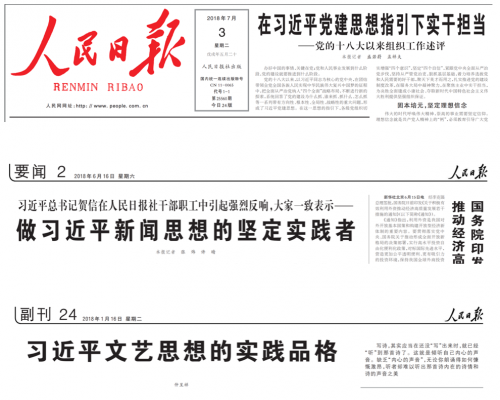
Among the various forms of “Xi Thought,” the ones used most frequently so far are “Xi Jinping Strong Military Thought,” “Xi Jinping Foreign Relations Thought,” “Xi Jinping Ecological Civilisation Thought” and “Xi Jinping Economic Thought with Chinese Characteristics” (习近平中国特色社会主义经济思想). The areas in blue show total number of articles using any one of the above-mentioned four leading forms of “Xi Thought” over the four quarters of 2018, while the areas in orange show the total number of articles using other forms of “Xi Thought.”
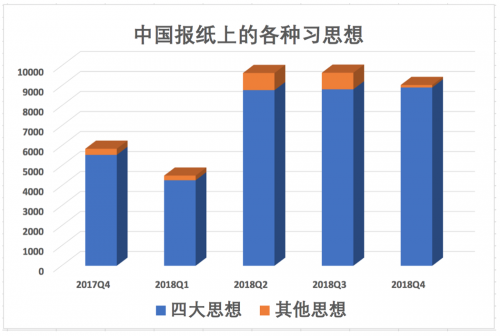
And here is how the four leading forms of “Xi Thought” appeared in the People’s Daily in 2018, with “Xi Jinping Strong Military Thought” clearly in the lead.
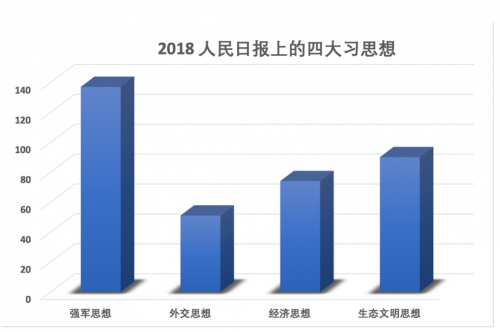
This prevalence of “Xi Jinping Strong Military Thought” will strike familiar notes for those who are students of the history of the Chinese Communist Party. They may remember that in August 1956, “Mao Zedong Thought” was actually removed from the Party Charter, with Mao’s nod of approval. That was three months after the start of the Hundred Flowers Campaign. But after the Lushan Conference (庐山会议) in 1959, during which Mao was sharply criticised for the failings of the Great Leap Forward, “Mao Thought” began to reemerge. It was a time at which it became clear that Mao’s personal power exceeded all notions of collective leadership. And we should note that the first permutation of “Mao Thought” to make a comeback was “Mao Zedong Military Thought” (毛泽东军事思想).
History is never very far behind.

